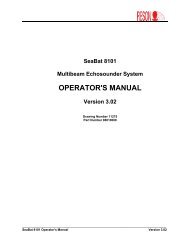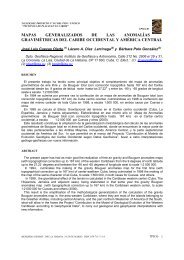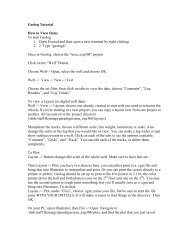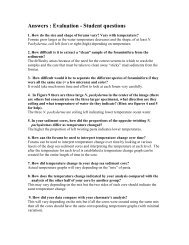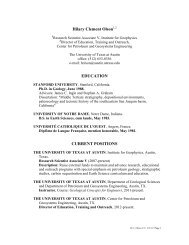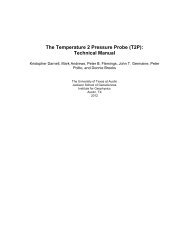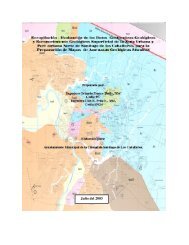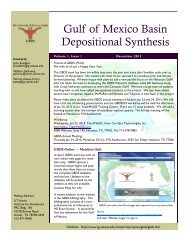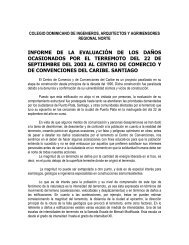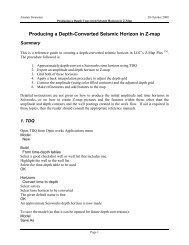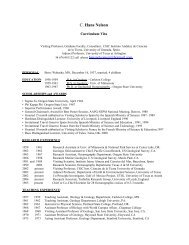IGCP Project short title: Caribbean Plate Tectonics Duration and ...
IGCP Project short title: Caribbean Plate Tectonics Duration and ...
IGCP Project short title: Caribbean Plate Tectonics Duration and ...
Create successful ePaper yourself
Turn your PDF publications into a flip-book with our unique Google optimized e-Paper software.
which were obducted during strike-slip movement. The eastern Veracruz basin opened<br />
during rotation of the Yucatan block. Sinistral offset across the Chiapas Strike-Slip fault<br />
zone may reflect partial decoupling from the rest of the Yucatan block. The western basin<br />
(Cordoba platform) was dropped downward at an early stage of rotation.<br />
26<br />
EVOLUTION OF THE CRETACEOUS TO RECENT OROGENIC BELT OF<br />
NORTHERN VENEZUELA<br />
SISSON, Virginia B. <strong>and</strong> AVÉ LALLEMANT, H. G<br />
The <strong>Caribbean</strong> Mountain system (Venezuela) is both a Modern <strong>and</strong> Ancient <strong>Plate</strong><br />
Boundary <strong>and</strong> Orogen. At first glance, this mountain range appears to be a classical orogenic<br />
belt with a metamorphic "Hinterl<strong>and</strong>" <strong>and</strong> a non-metamorphic "Forel<strong>and</strong>" fold <strong>and</strong> thrust<br />
belt. However, extensive dating (mostly 40Ar/39Ar) indicates that metamorphism of the<br />
hinterl<strong>and</strong> belt took place in mid-Cretaceous time, whereas the non-metamorphic forel<strong>and</strong><br />
rocks were deformed in Cenozoic time. This situation resulted from marked right-oblique<br />
convergence of the <strong>Caribbean</strong> <strong>and</strong> South American plates along their mutual EW-trending<br />
plate boundary zone. metamorphic rocks contain blueschists <strong>and</strong> eclogites <strong>and</strong> have formed<br />
in the Leeward Antilles subduction zone along which the Atlantic plate was subducted.<br />
Blueschists <strong>and</strong> eclogites were partially exhumed by arc-parallel stretching resulting from<br />
displacement partitioning along an oblique plate<br />
margin. The collision of the Leeward Antilles arc with South America resulted in obduction<br />
of the accretionary wedge onto the South American margin <strong>and</strong> change of subduction<br />
polarity. This obduction took place in Paleocene time in the west <strong>and</strong> is still occurring in the<br />
east. The development of forel<strong>and</strong> basins <strong>and</strong> the forel<strong>and</strong> fold <strong>and</strong> thrust belt was<br />
diachronous as well <strong>and</strong> young from west to east. The oblique convergence rate vector was<br />
strongly partitioned into a plate-boundary normal component that resulted into the southvergent<br />
fold <strong>and</strong> thrust belt <strong>and</strong> a plate-boundary parallel component resulting in boundary<br />
parallel right-lateral strike slip faults along which the metamorphic belts were displaced<br />
toward the east. In addition, subduction related processes vary along strike. In the west, two<br />
high-pressure belts (Cordillera de la Costa <strong>and</strong> Villa de Cura belts) occur whereas in the east,<br />
(Margarita Isl<strong>and</strong>) only one<br />
exists. The Cordillera de la Costa belt contains eclogites that were formed at ~70 km depth.<br />
Eclogites on Margarita formed at ~45 km depth. The Villa de Cura belt blueschist formed at<br />
~30 km depth. The age of exhumation varies from mid-Cretaceous (Villa de Cura <strong>and</strong><br />
Margarita) to Eocene (Cordillera de la Costa). The dependence of depth of metamorphism<br />
<strong>and</strong> timing of exhumation of these high-P rocks on plate tectonic configuration is<br />
complicated, because of Tertiary overprint.<br />
INTERCRATONIC OROGENS: THE CARIBBEAN AND SCOTIA ARCS<br />
DALZIEL, Ian W.D., LAWVER, Lawrence A., GAHAGAN, Lisa M., <strong>and</strong> MANN, Paul.<br />
The <strong>Caribbean</strong> <strong>and</strong> Scotia arcs are two striking features of any tectonic map of the<br />
Earth <strong>and</strong> are in fact nearly identical in size. They are respectively located between North<br />
<strong>and</strong> South America, <strong>and</strong> South America <strong>and</strong> Antarctica, joining the North American<br />
Cordillera to the Andes, <strong>and</strong> the Andes to the West Antarctic continental margin orogen.<br />
Their tectonic evolutions can be related to the relative motion between the two pairs of<br />
cratons. Their evolving physiography produced critical controls, varying with time, on the<br />
movement of biota between the cratons, <strong>and</strong> between the Pacific <strong>and</strong> Atlantic Oceans. The<br />
<strong>Caribbean</strong> arc differs from the Scotia arc with the presence of the Central American l<strong>and</strong><br />
bridge. Yet differential motion along the Shackleton Fracture Zone between Cape Horn <strong>and</strong><br />
the tip of the Antarctic Peninsula has produced a ridge as shallow as 700 meters. This ridge<br />
with only minor changes in plate<br />
motions could develop into a subduction zone <strong>and</strong> generate an isl<strong>and</strong> arc. Absence of a<br />
South America-Antarctica l<strong>and</strong> bridge permits a complete <strong>and</strong> vigorous wind-driven circum-<br />
Antarctic current <strong>and</strong> intense sediment scour in Drake Passage. Cenozoic magnetic<br />
anomalies have been identified in Drake Passage <strong>and</strong> the eastern Scotia Sea where oceanic<br />
crust was formed as Antarctica separated from South America. High sedimentation rates,<br />
possible formation during the Cretaceous Normal Superchron, <strong>and</strong> a large igneous province<br />
26



